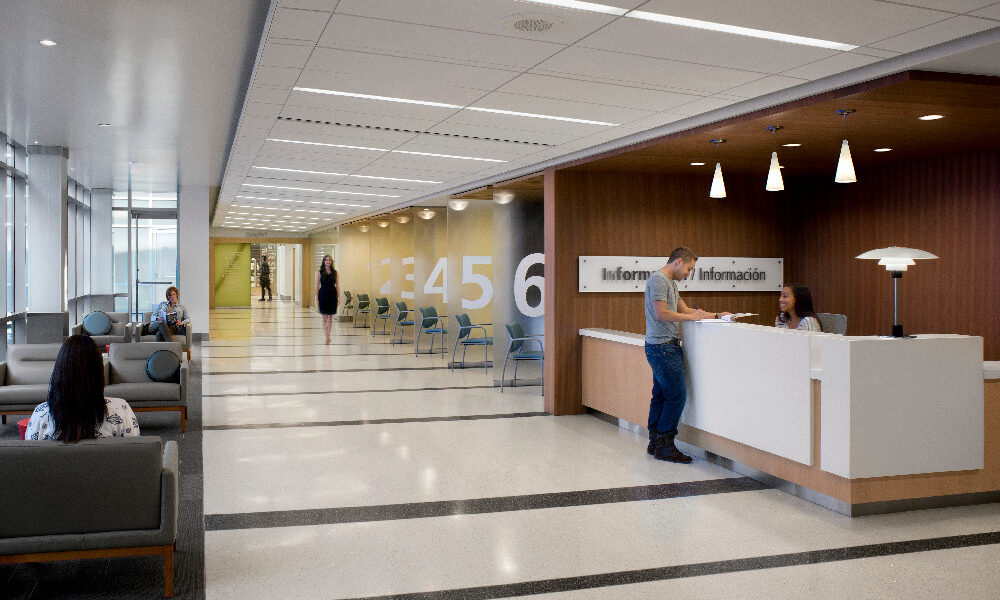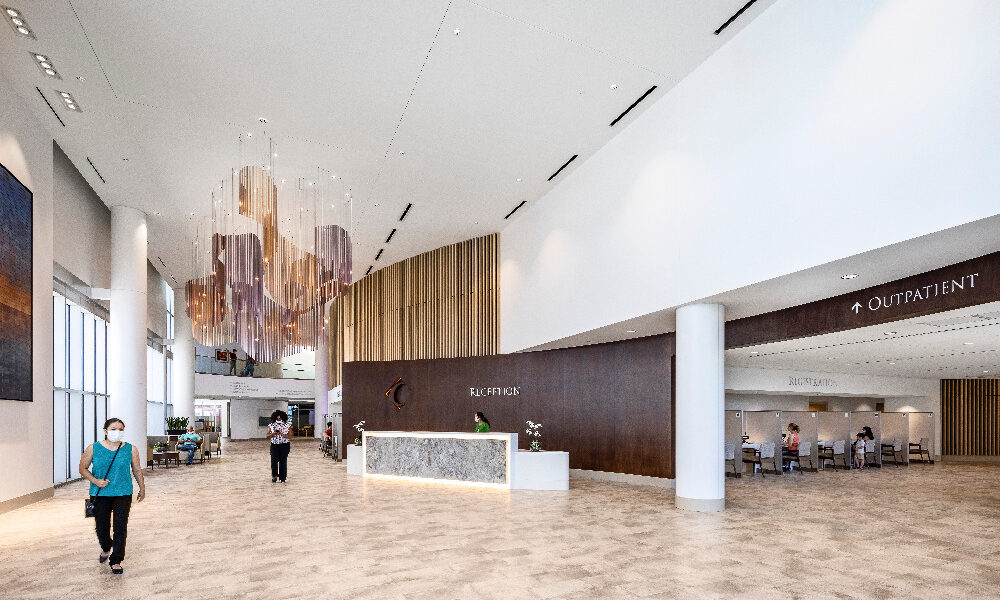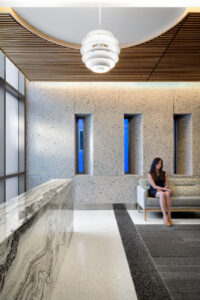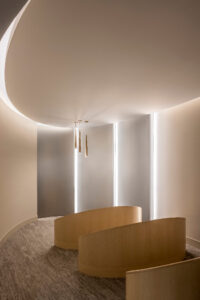 Design played a major role in attracting staff for the new Martin Luther King Jr. Community Hospital in Los Angeles, California. Photo by: David Wakely Photography
Design played a major role in attracting staff for the new Martin Luther King Jr. Community Hospital in Los Angeles, California. Photo by: David Wakely Photography  Design for Clovis Community Medical Center’s expansion project in Central California needed to appeal to potential local medical staff, as well as care providers traveling from other states. Photo by: Lawrence Anderson Photography
Design for Clovis Community Medical Center’s expansion project in Central California needed to appeal to potential local medical staff, as well as care providers traveling from other states. Photo by: Lawrence Anderson Photography Subscribe Now
Rethinking Healthcare Design to Address Post-Pandemic Workforce Shortage
By Julian Lopez and Kirk Rose
Addressing incentive factors, safety + cultural differences
When discussing healthcare design, the vernacular among architects and designers must revolve around the patient experience, healing environments and promoting healthier local communities. This familiar verse among healthcare professionals has positioned architects and design firms to create the next best healthcare facility by the formulations of Evidence-Based Design. Then came COVID-19, and the necessity for healthcare facilities to reinvent themselves throughout the pandemic.
The world has not been the same and neither has the healthcare workforce, which has been exhausted and burned out from facing COVID-19 since early 2020. As a result, the healthcare workforce crisis threatens organizations, while hospital employment continues to decline.
“Prioritizing design around the patient experience is no longer the only priority,” said Alta Hospitals CEO Dr. Hector Hernandez. “For the first time in my 30 years in healthcare administration, I have had to become extra creative by finding ways to retain nursing and clinical ancillary staff. This has included additional breakrooms, Zen-type meditation rooms and spaces to provide pet therapy for employees and physicians, while enhancing cafeteria services that operate 24/7. Design cannot be ignored because it now accounts for what nurses and staff are looking for when joining Alta Hospitals.”
What does this ultimately mean for healthcare designers? The following key insights on catering designs to attract healthcare staff have been garnered over the last few years:
Accounting for healthcare workforce incentive factor
More than ever, designing support areas for healthcare providers — such as staff lounges, staff dining facilities and physician on-call rooms, among other spaces — must be closely analyzed and programmatically defined to account for the healthcare workforce incentive factor.
When Los Angeles County board of supervisors Mark Ridley-Thomas, who oversaw construction of the new Martin Luther King Jr. Community Hospital, asked HMC to design the building, part of his request was that “the people from South Los Angeles should feel they were getting the same quality building as the people of Beverly Hills.”
The hospital was to be run by a newly formed operator, MLK Healthcare Corp, leasing the facility from the county of Los Angeles. Thus, the entire hospital staff was to be hired anew, beginning with the CEO. It was considered a challenge to attract high-quality staff to South Los Angeles, a portion of the city some saw as a less desirable workplace.
When the project was under construction, the MLK Healthcare Corp advertised 600 positions and was elated to receive 3,000 applications from people who worked at places like Ronald Reagan UCLA Medical Center, Cedars Sinai and UC Irvine Medical Center. Applicants explained they felt drawn to the mission of MLK Community Hospital to serve the underserved, and they felt the beautiful new campus buildings and interiors would be a wonderful place to work.
Supporting those who care for patients
In another example, Clovis Community Medical Center’s phase C expansion included a significant expansion of 11 projects to double the campus’ beds and emergency, diagnostic, treatment and support capacity. Since Clovis is in Central California, and had an inadequate medical workforce to meet the needs of this and other projects in the growing community, it became necessary to attract medical staff, including traveling nurses from different parts of California and other states, to staff the newly expanded hospital and provide the care needed and projected by the community’s growth. The hospital was able to hire the staff more quickly than anticipated, with many applicants stating the Clovis Community Medical Center campus was the most attractive and pleasant option in the region.
The new inpatient care tower and outpatient treatment center and support building not only take into consideration what the design means for patient care, but also how it supports those who care for the patients. While staff safety is crucial, analyzing what that means on the other side of the pandemic has reactivated design efforts into a checklist of items.
Focusing on sustainability, staff safety + mental health
The Design-Build team of Hensel Phelps | HMC Architects | CO Architects is leading the design and construction of Harbor UCLA Medical Center’s replacement campus. Design tasks include analyzing how not only to best reflect high-quality patient care, but also how the design supports staff.
For example, patient-and-staff interaction hubs, such as check-in and registration areas, are designed with aesthetic precaution. Desking must include privacy panels, while other areas are divided with transaction glass windows where color and graphics help soothe environments. Taming design to care for patient privacy, as well as account for enhanced staff protection, has meant rethinking space-planning layouts where social distance is layered and preferred. Waiting areas where tandem seating once allowed for maximizing occupancy loads are now becoming dispersed to account for safety vs. overcrowding.
In addition to supporting enhanced patient care and operational and sustainable efficiency, the Design-Build team’s efforts with Harbor-UCLA address the importance of employee mental health. While the project aims for LEED Gold certification, ensuring sustainability goals are met throughout the campus program results in strong efforts to support employee wellness and reduce burnout and turnover.
Aesthetically, the design incorporates the surrounding environment. Local textures and colors of the harbor and calm local South Bay are reminiscent through material textures and curved finishes. Biophilic design concepts are used throughout; expanded visibility of the native landscape and natural light that seeps into the main lobby and other employee and patient areas allow staff and visitors to reset and restore mentally.
Adapting to cultural, generational differences
Alta’s Hernandez recommends focusing on spaces dictated by the local labor force and younger generations, but emphasizes how it is crucial to address diversity, equity and inclusion for the thousands of nurses and healthcare professionals coming from countries such as the Philippines, India, Canada and Mexico, among others. Their cultural differences must be addressed for better adaptation and cultural transgression issues related to their relocation to the United States.
Designing to accommodate tech
According to YM Careers Network, one of many recruiting organizations connecting millennials and Gen-Z healthcare talent with healthcare systems, it is essential to have modern, tech-friendly systems in place to attract today’s candidates. It’s important to design technology systems that support staff communication and efficiency, such as remote interview areas, intentional kiosk locations within hospitals and mobile-friendly interfaces and communication, all of which serve as part of the recipe for a tech-friendly recruitment approach.
For designers, this means heightening knowledge of how we view and design around technology and cultural barriers. Design for the healthcare professional coming from another country and cultural background must account for religion, gender identification and ethnicity to make them feel welcomed and diminish possible barriers.
For instance, designing around technology to support staff communication and operating efficiencies means keeping an outlook for future technological needs and paying attention to how future healthcare talent will approach technology. This means not designing wall niches for queuing monitors or televisions in public waiting areas, as we’ve been used to, because we don’t know what the future holds for queuing system technologies or if a television of a specific display size will continue to serve an entire waiting area.
Designing for future generations
So, what does this all mean for healthcare designers and architects acclimating to this new healthcare era?
The answer is simple. Designing in post-pandemic times requires addressing not only the immediate urgencies that will mitigate a dwindled workforce, but continuing to design for future generations, while not overlooking a tune-up of the true healthcare engine — the healthcare workforce.
Author: Julian Lopez and Kirk Rose
Julian Lopez, NCIDQ, IIDA, is a senior project designer at HMC Architects. Kirk Rose, AIA, DBIA, is the healthcare practice leader at HMC Architects.
Tags: COVID-19, Design-build, Evidence-Based Design, staff well-being, Sustainability, workforce shortage
Posted February 14, 2024
More Articles:
- CxA Workshop & Exam
Apr 29, 2024 – Apr 30, 2024 - EMP Seminar & Exam at CxEnergy 2024
Apr 29, 2024 – Apr 30, 2024 - CxEnergy
Apr 29, 2024 – May 2, 2024 - PHCC West 2024
Apr 29, 2024 – May 2, 2024 - Lean in Design Forum 2024
May 1, 2024 – May 2, 2024 - IFMA’s Facility Fusion Conference & Expo
May 5, 2024 – May 7, 2024 - ASHE Academy 2024
May 6, 2024 – May 10, 2024












